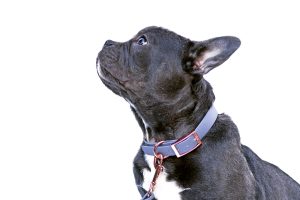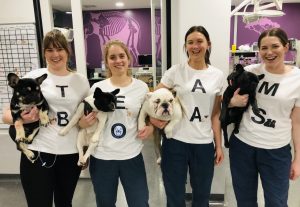 Having long held a specific interest in brachycephalic breeds, with particular emphasis on airway disease and lameness, Dr Karin has become one of Australia’s most experienced surgeons, mainly evidenced from the many revision surgeries that our clinic see’s.
Having long held a specific interest in brachycephalic breeds, with particular emphasis on airway disease and lameness, Dr Karin has become one of Australia’s most experienced surgeons, mainly evidenced from the many revision surgeries that our clinic see’s.
Many pet owners having had BOAS surgery in Melbourne (often via specialist surgeons), with relatively poor results, have sought a second opinion from Karin, with re-assessments often finding the following:
– A palate has only been partially resected compared to what we remove at Melbourne Bulldog Clinic (MBC)
– Palates have rarely been thinned, being left with a thickness that takes up a significant proportion of the little room these dogs have in their pharynx.
– Laryngeal saccules either left (seen in the vast majority of patients) or only partially removed, needing to be revised.
– Tonsils incorrectly assessed as normal and left in that would benefit from being removed.
– Nares not deepened or widened as much as MBC would.
Our revision surgeries almost always result in vastly improved patients. Hence, we have learnt over the years that there is great variability and subjectivity from surgeon to surgeon with regards to the 5 aspects that can be corrected in BOAS. Dr Karin, through approximately 1,500 surgeries over the years, is one of Australia’s most experienced, but also most progressive surgeons, given the results from the revision surgeries we have performed.
Working in combination with Dr Marcus Hayes from the medical aspect, MBC has significantly refined not only the surgical correction of BOAS sufferers, but also their management from a medical and behavioural concern. This has helped us achieve a far greater safety record from surgery itself, as well as the best possible long-term improvement after airway correction.
 Through two separate studies we have had the following results:
Through two separate studies we have had the following results:
Study 1: 67 cases 3 months post boas showed 0% worse, 2% no change and 98% improved with the vast majority being significantly improved.
Study 2: 150 cases 12 months post-surgery showing 7% no change, 93% improved with the vast majority significantly improved.
Given almost 100% of non-airway corrected dogs show significant deterioration in exercise ability from year to year, the 12-month stats above are remarkable. The 7% no change dogs will likely have been the severely progressive ones had their airways not been improved.
One concern people have with BOAS surgery however, is the potential for post-surgical swelling and complications such as aspiration pneumonia, the need for a temporary tracheotomy tube or even death. The following highlights how we have virtually minimised these risks by modifying traditional methods.
Modifications MBC has made to minimise BOAS surgical risks
One of Australia’s leading and world-renowned specialist centres for BOAS surgery have communicated their following overall complication rates, feeling they are on the lower end of the scale on a world basis:
– Approximately 17% need oxygen treatment for 36 hours
– Approximately 5% have major complications such as aspiration pneumonia and the need of a temporary tracheotomy tube to help them breathe.
– A range of 0.5 to just under 1% death rate
In comparison, MBC have recorded the following concerns through approximately 2,300 surgeries:
– No dogs needing oxygen treatment for 36 hours.
– 0% aspiration pneumonia (1 case developed these 5 days post-surgery despite being 100% in those initial 5 days, but quickly resolved)
– 0.8% tracheotomy tubes (of which about 1/3 were placed electively pre-extubation for very high-risk patients in late stage 2 laryngeal collapse)
– 0.1% death rate (only 2 dogs that delayed surgical correction for too long and were very high-risk cases. We have corrected 50-100 such high-risk cases with no concern)
Hence our advice is that through progression of both surgical techniques, and more modern medical and behavioural practices, we have resulted in an almost 10X reduction of severe complications or death than Australia’s leading specialist centres.
The following are the reasons for this:
1) A far more pro-active approach to maximising the room in the back of the pharynx via more length and thickness of palate removed, and removal of laryngeal saccules and tonsils in almost every case. In addition to this we also do a wider and deeper nares resection. All this extra room results in two advantages; far less chance of complications with post-surgical swelling, and far improved long term results.
2) A move away from traditional Nsaids to steroids as the best post-surgical anti-inflammatory. Nsaid’s do not reduce or prevent pharyngeal swelling to nearly the same extent as steroids. We urge all surgeons to understand the importance steroids play in minimising swelling and post-surgical reflux, which is very important to reduce the potential for aspiration pneumonia.
3) The use of metoclopramide preferentially to omeprazole for reflux control.
4) Allowing owner presence for any anxious dogs in recovery. This is another very important aspect of lowering complication rates. We urge specialists to understand the importance of this aspect of stress management to lessen post-surgical swelling. Many specialists still refuse owner presence when required. MBC surgeons will not schedule surgery unless you advise you are available if needed.
5) Same day discharge: Stress leads to swelling. Getting these dogs home once they are breathing well, (which is 2-5 hours for 99% of patients with above protocols), is key to higher success and recovery. We have followed many specialist cases that have resulted in aspiration pneumonia, temporary tracheotomy tube and even death, that were relatively fine immediately post-surgery, but started their downward spiral during the night of what we believe is the unnecessary 24 hour stay. We feel 24-hour stays greatly increase the risk of severe complications and death.
Upon discharge our highly experienced BOAS nurses give lengthy explanations to pet owners about what to look for should you need to consider going to your nearest emergency (a list is provided).
Through 2,300 surgeries which we have sent home the same day, only three people have been concerned enough to go to emergency (as 99% are showing improved and content signs since getting home). Two of these cases were fine and sent straight back home. One was kept 12 hours for observation with a tracheotomy tube placed (one of the 0.8% compared to 5% for Australia’s most renowned specialist centre for BOAS surgery).
Hence risks associated with BOAS surgery are virtually non-existent when modern surgical, medical and management protocols are followed, and patients are corrected early, before very advanced boas exists (8-14 months, breed dependent).
MBC have developed and refined these protocols over many years and urge all surgeons to open discussion to help as many of these dogs achieve the safest surgery and best long-term results possible.
Stage 3 Laryngeal Collapse And Bilateral Cuneiformectomy Pioneered By Karin In Australia
Stage 3 laryngeal collapse occurs when airway concerns are severe and chronic enough to cause the larynx cartilages to collapse, no longer opening with each breath. In the past this has generally led to either euthanasia or the need for a permanent tracheostomy. A permanent tracheostomy is a surgically created hole halfway down the neck through which the dog breathes for the rest of its life. These are expensive, complicated, and difficult to manage the first 6 months. Many people choose euthanasia instead.
Dr Karin Davids was a pioneer in Australia of bilateral cuneiformectomy, a procedure where we remove the two collapsed cartilages. Karin has talked some of Melbourne’s best surgeons through this procedure once they saw our own success with it.
With very good success now being demonstrated with bilateral cuneiformectomy, brachycephalic owners now have excellent choices for those severe cases who were left too long for airway correction.
